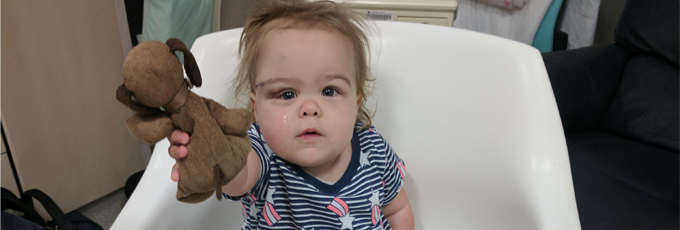
Neuroblastoma is the most common solid tumour cancers found in children mostly between the ages of 0 – 5. Erika was 16 months old at diagnosis but it is quite possible she had a tiny tumour when she was born.
- Neuro – meaning nerves
- Blastoma – meaning a cancer that affects immature or developing cells
Neuroblast cells are a normal part of embryo development. For reasons unknown, some don’t go through the process of maturing into nerve cells and they start growing out of control.
Primary tumours can be found anywhere along or near the sympathetic nervous system, so the spine, chest, neck, and pelvis or on the adrenal glands which is where Erika’s started.
Only about 40 children are diagnosed with Neuroblastoma each year in Australia so needless to say we felt pretty unlucky that Erika was one of those. About half of them are diagnosed under 2 years of age with 90% being under 5.
It can be difficult to diagnose as symptoms mostly don’t show until it has reached stage 4 and even then, they are often dismissed as other less serious childhood ailments. Swollen bellies from large tumours can be mistaken for constipation, general pain and irritability as teething or as in our case, a bruise around the eye as an accidental head knock. Erika’s bruising was caused by a secondary tumour in the bone next to her eye. Her primary tumour was small compared to many who present with more serious symptoms.
As it is so rare, most GP’s will have never had a patient present with neuroblastoma. We were fortunate that the 2nd GP we saw, was a retired pediatrician who had seen Erika’s symptoms before.
There are many different types and stages of neuroblastoma from benign to aggressive. Erika’s was stage 4 and considered ‘high risk’.
The plan for Erika’s treatment was much the same as most neuroblastoma patients with similar diagnosis. The treatment is complex and they pretty much throw the whole arsenal at it.
Induction therapy – meant to kill and/or remove the tumours:
- 6 rounds of chemotherapy on a 21 day cycle
- A bone marrow harvest (between rounds 1 & 2 of chemo)
- Surgery to remove as much of primary tumour as possible
Consolidation Therapy – to kill any remaining cancer cells and prevent new ones forming
- High dose chemotherapy followed by an autologous bone marrow rescue (similar to a bone marrow transplant except she would receive her own bone marrow collected during the harvest, instead of a donor)
- A second high dose chemotherapy followed by another bone Marrow rescue
- Radiation (how much depended on the result of all treatment up to this point)
- 6 rounds of immunotherapy and isotretinoin alternating between the two
It’s harsh, cruel, life threatening and sometimes unbearable for all, but it is the best chance each child has to live a full live. With all of these treatments, the long term prognosis is still only around 50/50. Without them all, it’s very low.
The full protocol and potential outcome was incredibly overwhelming so Nicole made the decision to focus on one step at a time. It would prove no purpose to get too far ahead of ourselves and in fact it would mean not being fully aware and present in Erika’s day to day struggles. So we tried to plan for each round as they came up and live one day at a time. For us, there was no other way to get through what was to come.